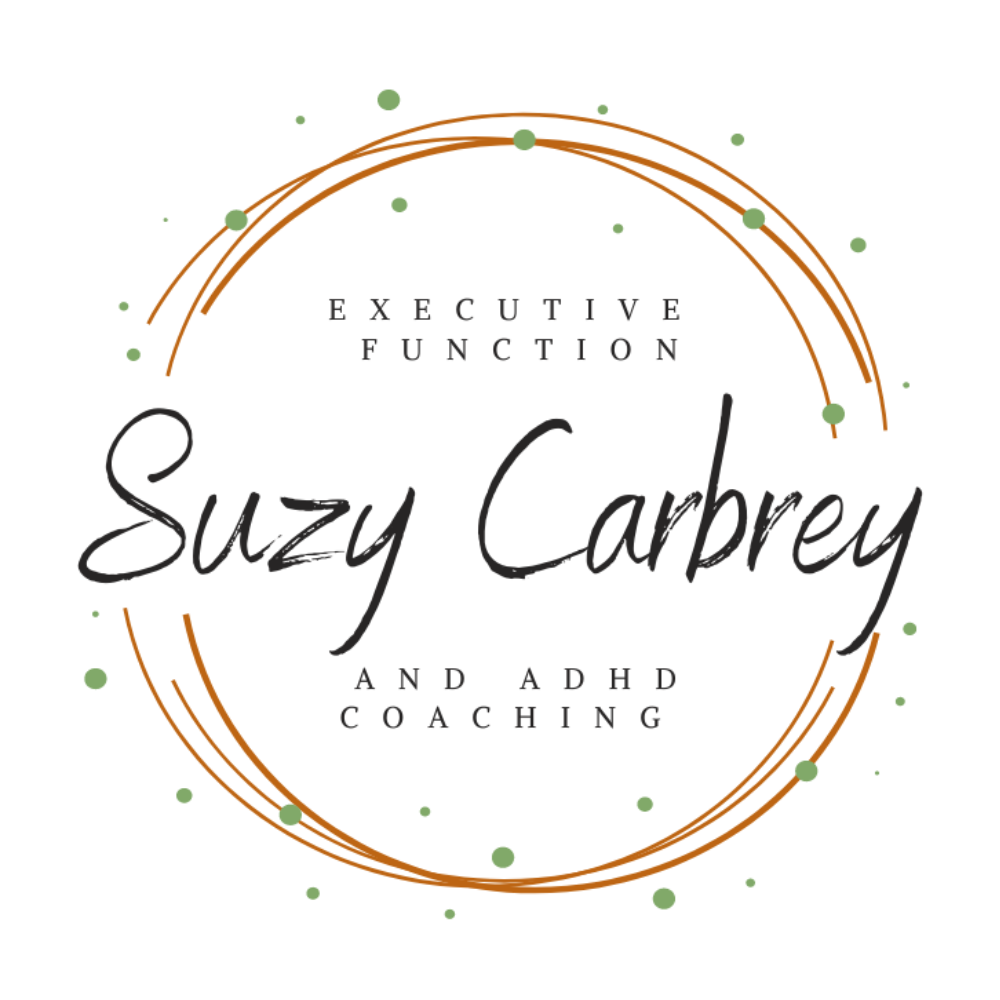Written by Suzy Carbrey ⧫
Have you ever wanted to have a deeper understanding of your reactions to life?
 In this article, I will explain the key principles of Polyvagal Theory and discuss how to use this framework to enhance executive functioning. We will explore the connection between the brain, body, and environment. Understanding this connection is critical for enhancing executive functions. By implementing practices that align with this holistic approach, you can support the reshaping of our nervous system and optimize cognitive processes. Let’s dive in!
In this article, I will explain the key principles of Polyvagal Theory and discuss how to use this framework to enhance executive functioning. We will explore the connection between the brain, body, and environment. Understanding this connection is critical for enhancing executive functions. By implementing practices that align with this holistic approach, you can support the reshaping of our nervous system and optimize cognitive processes. Let’s dive in!
What is Executive Functioning?
Executive functioning refers to the cognitive (thinking) processes that enable us to plan, organize, prioritize, manage our time, and regulate our behavior effectively. It plays a crucial role in our ability to accomplish tasks, make decisions, and navigate complex social interactions.
Individuals with ADHD often experience difficulties with executive functioning, including challenges with attention and focus, organization and planning, impulse control, emotional regulation, working memory, task initiation and completion, and cognitive flexibility. These difficulties can impact various aspects of daily life, academic or work performance, and interpersonal relationships.
Executive functioning doesn’t reside solely in the brain; it emerges from the interactions between the brain, body, and environment. Our body’s states, sensations, and movements influence our cognitive processes.
What is Polyvagal Theory?
Polyvagal Theory is a framework created by Dr. Stephen Porges that helps us understand how our body’s autonomic (automatic) nervous system affects how we interact with others, regulate our emotional responses, and our overall well-being. It shows us how our physical condition is linked to our ability to form relationships and adjust to our surroundings. The theory suggests that our nervous system has three states. According to Polyvagal Theory, it is important for us to feel secure and connected in order to function at our best.
A Hierarchy of Nervous System States
Polyvagal Theory helps us understand how our body’s autonomic nervous system works and how it affects our social interactions, emotions, and overall well-being. It focuses on a nerve called the vagus nerve, which plays a big role in this system. The theory divides the autonomic nervous system into three states: ventral vagal (social engagement), sympathetic (fight or flight), and dorsal vagal (immobilized).
The Three States
The first state, ventral vagal, is the highest level in which we feel safe, connected, and able to interact with others in a positive way. It helps us see options and make choices because our nervous system is calm and regulated. This allows us to consider different options, think carefully about decisions, and feel like we have control over our choices.
The second state, sympathetic, is in the middle. This state is activated in response to perceived threat or danger. It triggers the fight or flight response, preparing the body for action and mobilizing energy resources to deal with the perceived threat.
The third state, dorsal vagal, is the lowest level. In this state, our body is immobilized while focused on rest, digestion, and recovery. It’s all about providing the necessary resources for our survival and saving our energy.
Responses to the Environment: The ADHD Nervous System May Be More Sensitive
Ventral vagal is our default when we feel safe and connected. If safety is compromised, the sympathetic state kicks in to prepare our body for fight or flight. The dorsal vagal state is activated in more extreme situations when our safety is perceived to be severely compromised.
Understanding this hierarchy helps us see how our body responds to different situations. By promoting safety, connection, and self-regulation, we can support the higher-level states and improve our overall well-being. Practices like mindfulness, physical activity, and emotional regulation can help us activate the socially engaged state and make our nervous system work optimally.
How can we use Polyvagal Theory to Support ADHD?
Feeling safe and connected is integral for optimal executive functioning. Polyvagal Theory supports emotional regulation, attention, and cognitive flexibility. It is such a powerful tool that can help you shift the state of your nervous system to help you feel more focused, calm, and happy doing the things you want in life.
It is such a powerful tool that can help you shift the state of your nervous system to help you feel more focused, calm, and happy doing the things you want in life.
Polyvagal Theory provides insights into the physiological and psychological factors that impact our ability to engage in executive functions. Our brains generate predictions based on past experiences to interpret and make sense of the world. These predictions are not solely based on cognitive factors but also incorporate bodily sensations and contextual cues.
By understanding the interplay of the autonomic nervous system, we can create supportive environments and develop targeted interventions to optimize executive functioning.
Reshaping Your Nervous System for Optimal Executive Functioning
Deb Dana is a therapist and author who has developed a helpful way of understanding and working with our nervous system. She teaches techniques that can be used to map our nervous systems in order to regulate our body’s responses to stress and trauma. By learning about how our nervous system functions and recognizing our own unique responses, we can better manage our well-being and restore a sense of safety. Dana’s work has been influential in helping therapists and individuals alike navigate the challenges of stress and trauma, promoting self-regulation and overall functioning.
You Can Map Your Own Nervous System!
Mapping your nervous system is such a powerful tool that can help you shift the state of your nervous system to help you follow through with tasks and feel more confident. The process helps develop a deeper understanding of its functioning and supports the optimization of executive functioning.
Anchors Help Us Feel Focused and Calm
Anchors in Polyvagal Theory are tools and techniques that help us regulate our nervous system and feel safe and calm. They can be things outside of us, like soothing music or comforting touch, or practices we do internally, like deep breathing or mindfulness. Anchors help us shift between different states, like from feeling stressed to feeling relaxed. By using anchors, we can better manage our emotions, cope with challenges, and promote a sense of well-being and resilience.
To map the things that keep you engaged and connected, find personalized anchors that help you stay focused. These anchors can be people, places, objects, or routines that remind you of safety and connection. Notice how your body feels comfortable with these things and reflect on positive experiences to identify common factors that contribute to your engagement. Pay attention to the emotions you feel, like joy and belonging, and recognize your personal strengths that support social interaction. By being mindful of these factors, you can better understand what helps you stay engaged in social settings and in life.
Triggers Can Make Us Feel Anxious or Shutdown
Triggers in Polyvagal Theory are things that set off our body’s automatic responses when our nervous system senses threat or danger. Triggers can come from the environment around us or our own internal experiences. These can also be people, places, objects, sensory experiences, or habits. When we encounter triggers that make us feel unpredictability or threat, our body prepares for fight or flight, getting us ready to deal with possible danger. There are also triggers that can overwhelm and immobilize us leading to shutdown. By understanding these triggers and how they affect us, we can learn to manage our responses and promote a sense of safety and well-being.
To map the things that set off our body’s automatic responses when we sense threat or danger, there are a few helpful steps. First, pay attention to how your body and emotions react in different situations. Notice any changes like increased heart rate, tense muscles, or feelings of fear or anxiety. Reflect on past experiences where you felt unsafe and consider what triggers were present. Keeping a journal can also be useful for recording situations and your reactions, both positive and negative. This process takes time and self-compassion, and working with a therapist or coach that can provide additional guidance and support if needed.
Reshaping Responses and Behaviors: Empowering ADHD Through Nervous System Support
In Polyvagal Theory, “glimmers” are the small signs or signals from the world around us that make us feel safe, connected, and happy. They can be things like a friendly smile, a comforting voice, or positive memories. When we notice these glimmers, our body and mind respond by feeling calm, secure, and ready to connect with others. Glimmers help us reduce stress and create positive social experiences. By paying attention to these subtle cues, we can create environments that make us feel safe and connected, leading to better relationships and overall well-being.
Savor Positive Experiences
Savoring glimmers, along with positive experiences and achievements, can play a significant role in reshaping our nervous system responses and promoting emotional regulation and motivation. When we savor glimmers, we consciously and intentionally focus on the positive aspects of these experiences, allowing us to fully appreciate and internalize the feelings of safety, connection, and joy they evoke.
By savoring glimmers and positive experiences, we activate the brain’s reward system, releasing chemicals like dopamine that reinforce positive emotions and feelings of accomplishment. This process helps regulate our emotions by counteracting stress and promoting a sense of well-being. Moreover, savoring glimmers can enhance our self-efficacy and motivation by reminding us of our past successes and the challenges we have overcome.
Empowering Your ADHD Journey: Overcoming Difficulties and Achieve Sucess
 Reflecting on past achievements and challenges strengthens our belief in our abilities and resilience. This sense of accomplishment and self-efficacy can positively influence our nervous system responses, fostering a greater sense of confidence, motivation, and resilience when encountering future challenges.
Reflecting on past achievements and challenges strengthens our belief in our abilities and resilience. This sense of accomplishment and self-efficacy can positively influence our nervous system responses, fostering a greater sense of confidence, motivation, and resilience when encountering future challenges.
Remember, reshaping the nervous system takes time and consistency. Be patient with yourself and embrace the process as you integrate these practices into your daily life. Small steps taken consistently can lead to significant improvements in executive functioning over time.
Overall, by intentionally savoring glimmers and reflecting on positive experiences, we can reshape our nervous system responses by regulating our emotions, maintaining motivation, and cultivating a positive outlook. This practice empowers us to navigate life’s challenges with greater resilience and tap into our inner resources for growth and well-being.
On a Final Note
Incorporating Polyvagal Theory into our understanding of executive functioning opens up new possibilities for supporting individuals in developing and optimizing their cognitive abilities. By recognizing the role of the autonomic nervous system, we can create environments that promote safety, connection, and emotional regulation—critical factors for executive functioning.
By implementing strategies aligned with the brain-body connection, you can enhance cognitive processes and improve executive functioning. Remember, it’s a journey that requires patience and consistency. By nurturing this holistic approach, you can unlock your full potential and achieve greater success in planning, decision-making, and navigating complex tasks.
Begin Online Coaching for Executive Functioning / ADHD
Ready to gain control and enhance your executive functioning? As an experienced and compassionate coach, I specialize in providing support for executive functioning and ADHD. To embark on your journey, please reach out to me at 708-264-2899 or email hello@suzycarbrey.com to schedule a FREE 20-minute discovery call consultation.
With a background as a speech-language pathologist, I have a strong foundation in executive functioning coaching. My graduate degree program in SLP placed a significant emphasis on cognition, including executive functions, and I have years of experience in medical rehabilitation, providing cognitive-communication therapy. Additionally, I have completed an ADHD Services Provider certification program, I am Solutions-Focused Brief Therapy Diamond Level 1 certified and I am trained in the Seeing My Time® executive functioning curriculum.
Experience the convenience and effectiveness of online coaching, backed by studies that demonstrate equal results to in-person services. Parents, professionals, and emerging adults love the convenience and privacy of receiving coaching from their own homes.
Whether you reside in Chicago, Milwaukee, Indianapolis, Kansas City, or anywhere else around the globe, I am here to assist you. Schedule your discovery call consultation today, and I eagerly anticipate the opportunity to work with you!
Please note that although I am a certified speech-language pathologist, all services Suzy Carbrey LLC provides are strictly coaching and do not involve clinical evaluation or treatment services. If you require a formal speech therapy evaluation and treatment, please inform me, and I can provide appropriate recommendations.

